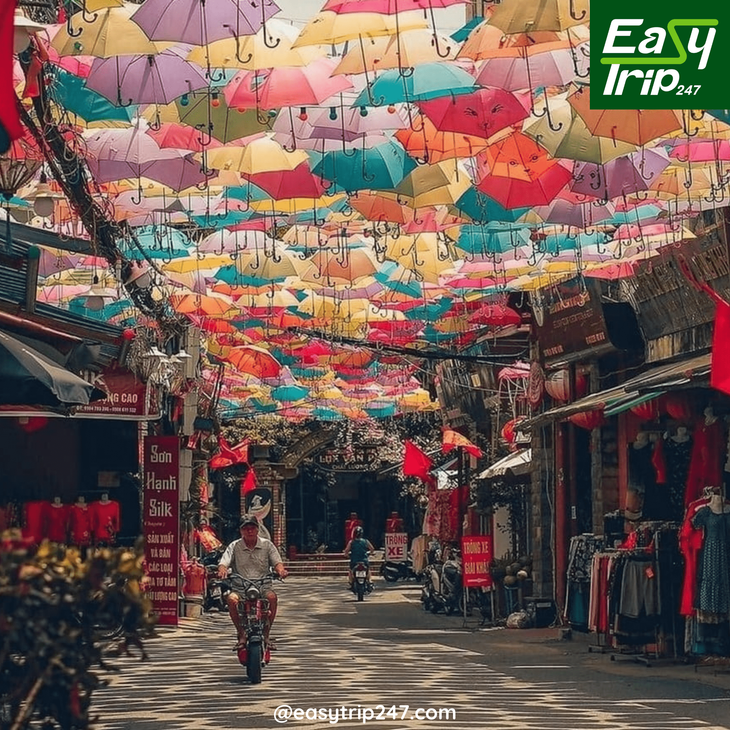
One of the most rewarding ways to explore Hanoi’s vibrant and intricate culture is through a walking tour in Hanoi, particularly an artisan-focused one. A "Craft Street Secrets" tour offers a deep dive into the hidden corners of Hanoi’s most creative neighborhoods, where artisans meticulously craft everything from silk to ceramics, woodwork to metal art. This unique walking tour in Hanoi unveils the secrets behind some of the city's most treasured crafts, offering visitors a chance to see artisans at work, learn about their techniques, and understand the cultural significance of their creations.
1. Exploring Hanoi’s Craft Streets
A walking tour in Hanoi centered around the city’s rich craft heritage takes you to specific areas that have long been home to skilled artisans. Old streets like Hang Bac (Silver Street), Hang Gai (Silk Street), and Hang Duong (Sugar Street) in the Old Quarter are some of the best-known spots to visit. These ancient streets have been part of Hanoi’s vibrant trading network for centuries and still preserve the traditional art of their craft. As you wander through these lively streets, you’ll be mesmerized by the sights and sounds of artisans crafting their wares in open workshops. Whether it’s the rhythmic tapping of a hammer shaping metal or the delicate weaving of silk, the energy of these craft streets offers an immersive experience for anyone on a walking tour in Hanoi. Each street tells its own unique story, and exploring them on foot is one of the best ways to understand the importance of Hanoi’s traditional crafts.
2. Hang Gai Street: The Silk Weaver’s Haven
One of the highlights of any artisan walking tour in Hanoi is a visit to Hang Gai Street, also known as Silk Street. As you stroll down this historic street, you’ll find yourself surrounded by the rich colors and textures of traditional Vietnamese silk. Hang Gai is renowned for its silk production, a craft that dates back to the 13th century. The street is lined with small boutiques and workshops where you can witness artisans hand-weaving the delicate fabric using traditional techniques passed down through generations. From the finest embroidered silk garments to intricate scarves and accessories, the silk produced here is a true testament to Vietnam's craft heritage. A walking tour in Hanoi offers visitors a chance to meet these talented artisans, observe their process, and even purchase high-quality silk products directly from the source. This immersive experience allows you to connect with the centuries-old traditions that make Hanoi's silk industry so famous.
3. Hang Bac Street: The Silver Artisan District
Hang Bac Street is another must-visit destination during a walking tour in Hanoi, especially for those interested in metalwork and jewelry. Known as Silver Street, this area has been the hub of silver craftsmanship for centuries. Here, you can find a variety of silver products, from delicate jewelry and intricate accessories to ceremonial items and traditional trinkets. The silver artisans of Hanoi are highly skilled, and many of them still use traditional methods passed down through generations. During your walking tour in Hanoi, you’ll have the opportunity to visit these small workshops where craftsmen and craftswomen create their masterpieces with remarkable precision. Watching them work with their hands—carefully shaping, polishing, and engraving the metal—provides a fascinating glimpse into the artistry behind each piece. Hang Bac Street offers a rich, hands-on experience for visitors, and the silver items found here make for exquisite souvenirs, each carrying the essence of Hanoi’s artisanal legacy.
4. The Secret World of Pottery in Bat Trang Village
A walking tour in Hanoi wouldn’t be complete without venturing to the famous Bat Trang Village, just a short distance from the city center. Bat Trang is known as one of Vietnam’s most iconic pottery villages, and it’s here that you’ll discover the artistry and craftsmanship behind Vietnam’s signature ceramics. A visit to Bat Trang allows you to witness the entire pottery-making process—from the shaping of clay to the intricate glazing techniques that make these pieces so unique. The village has been producing pottery for over 1,000 years, and many of its artisans still use traditional methods passed down through generations. On your artisan walking tour in Hanoi, you’ll have the chance to explore the many pottery workshops, watch artisans work on their wheels, and even try your hand at shaping clay. The village also has a vibrant market where you can purchase handcrafted ceramics, ranging from decorative vases to functional tableware. Bat Trang’s rich history and dedication to the craft make it a fascinating stop on any artisan walking tour in Hanoi.
5. Woodworking and Lacquerware in Hanoi's Old Quarter
Another intriguing stop on your walking tour in Hanoi is the woodworking and lacquerware district, where you can explore traditional Vietnamese woodcraft. Hanoi has a long history of woodworking, and the Old Quarter is home to several workshops where skilled artisans carve intricate designs into wood and lacquer them to create stunning pieces. You’ll find everything from ornate furniture and home decor to beautifully crafted wooden statues and accessories. The process of creating lacquerware is an art in itself, with artisans layering lacquer on wood and then polishing it to a beautiful finish. As you explore these workshops during your walking tour in Hanoi, you’ll learn about the history and cultural significance of these art forms. The craftsmanship involved in creating these pieces is remarkable, and many of the workshops offer the chance to buy hand-crafted wooden and lacquer items as souvenirs, each one a unique reflection of Hanoi’s rich artisan traditions.
6. Bamboo and Rattan Craftsmanship in Hanoi’s Surrounding Villages
For those looking to experience a more rural aspect of Hanoi’s artisan community, a visit to the bamboo and rattan crafting villages on the outskirts of the city is highly recommended. These villages have been producing woven goods for generations, and a walking tour in Hanoi will provide an in-depth look at this intricate and sustainable craft. Artisans in these villages skillfully transform bamboo and rattan into furniture, baskets, mats, and other everyday items, all made by hand using methods that have remained largely unchanged for centuries. The process is both labor-intensive and intricate, requiring a great deal of skill and patience. A visit to these villages provides not only a chance to see these artisans at work but also an opportunity to purchase beautifully crafted, eco-friendly bamboo and rattan products directly from the source. It’s a perfect example of how Hanoi’s artisan culture thrives in both the heart of the city and its rural surroundings.
7. The Artisan’s Heart of Hanoi: Engaging with Local Craft Communities
One of the most unique aspects of an artisan walking tour in Hanoi is the chance to engage directly with local craft communities. In many cases, artisans are eager to share their knowledge and passion for their craft, providing visitors with deeper insights into their techniques and creative processes. These personal interactions foster a greater appreciation for the skill and dedication involved in each piece, whether it’s a silk scarf, a silver necklace, or a handmade pottery vase. As you move from one workshop to the next, you’ll hear stories from artisans who have devoted their lives to perfecting their craft, and you may even be invited to try your hand at some of the techniques yourself. These intimate moments not only enrich your experience but also create lasting connections between you and the vibrant artisan community in Hanoi.
8. The Magic of Craft Street Markets
Another benefit of a walking tour in Hanoi is the opportunity to explore the craft markets, which are full of treasures waiting to be discovered. Whether it’s a bustling street market in the Old Quarter or a quieter village market, these vibrant spaces offer a wide range of handcrafted goods, from textiles to wooden carvings, pottery to silver jewelry. Craft markets are often the heart of local artisan activity, and a visit to these markets gives you a chance to see a broader spectrum of Hanoi’s artisan offerings. As you browse the stalls and interact with local vendors, you’ll find yourself immersed in the creative energy of Hanoi’s craft scene.
Conclusion: Unveiling Hanoi’s Artisan Legacy
Hanoi’s artisan heritage is a treasure trove waiting to be explored, and a walking tour in Hanoi focused on its craft streets offers a one-of-a-kind experience. From the vibrant silk markets of Hang Gai to the intricate silver workshops of Hang Bac, the city’s craft scene provides a rich, immersive experience for anyone looking to connect with the cultural heart of Hanoi. Whether you’re admiring the artistry in Bat Trang Village or exploring the lacquerware and woodworking districts, a walking tour in Hanoi allows you to experience the beauty, history, and skill of the artisans who have made this city famous for its craftsmanship. If you’re a lover of art, culture, and creativity, a craft-focused walking tour in Hanoi will undoubtedly be one of the highlights of your trip.
Design Your Tour Today And Get A Quote. Contact Us Here: +84.975.504.825
Source: Easytrip247 Team compiled.
